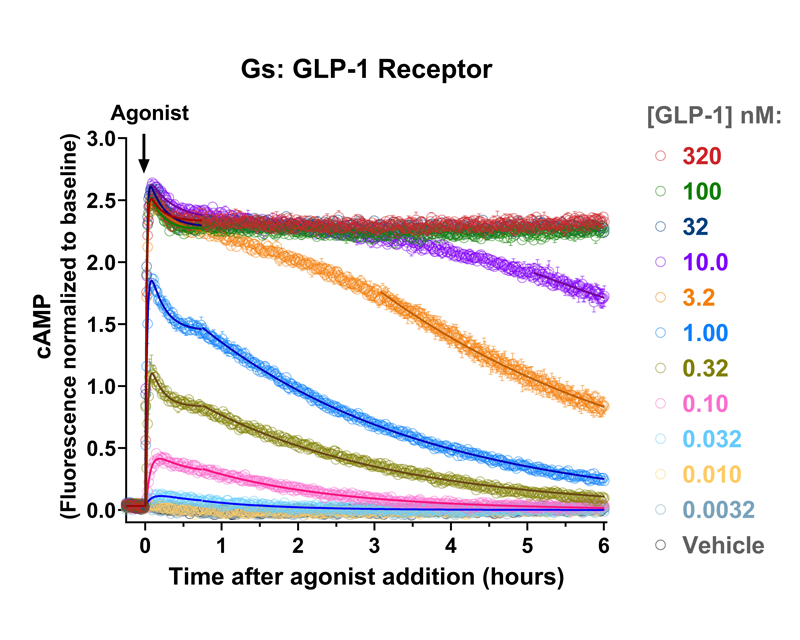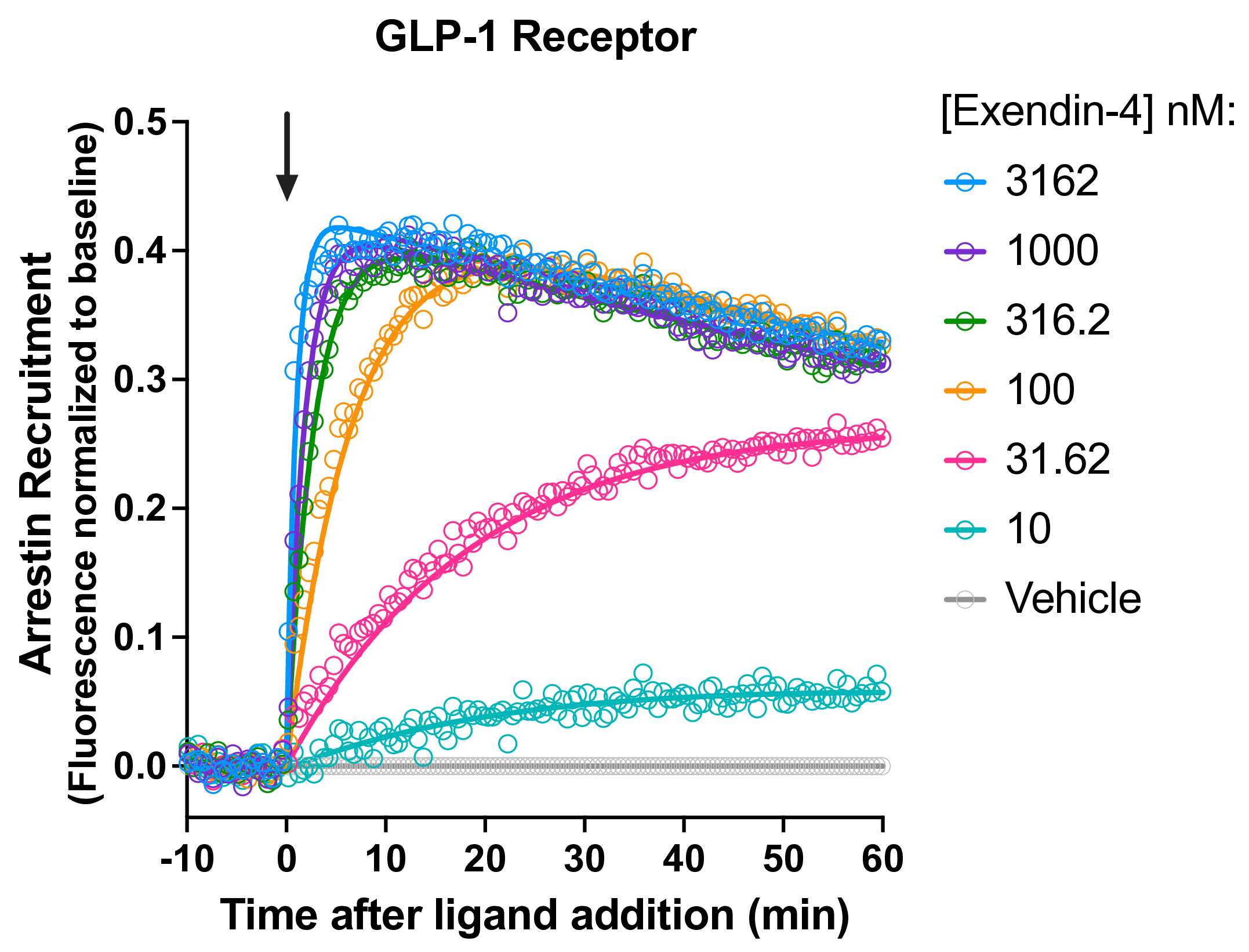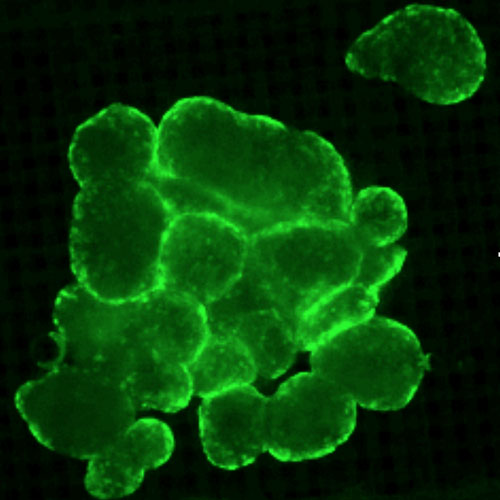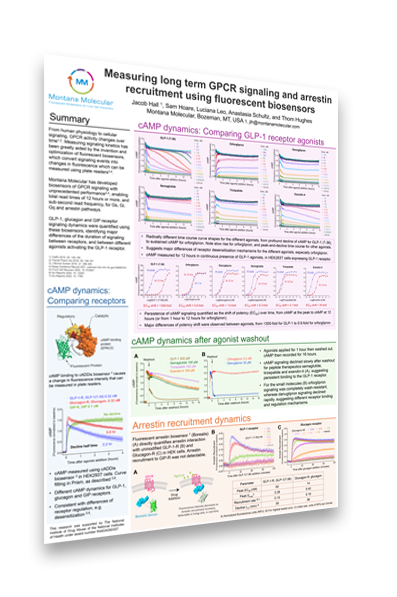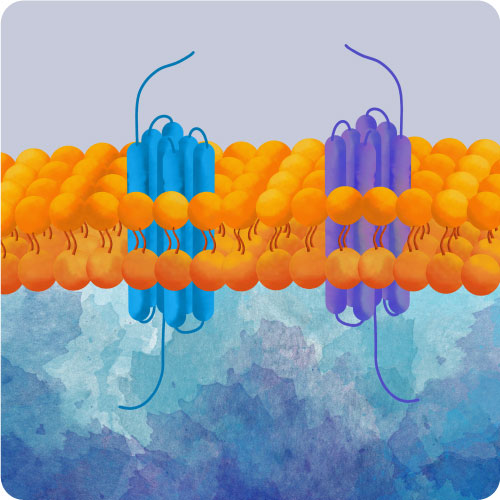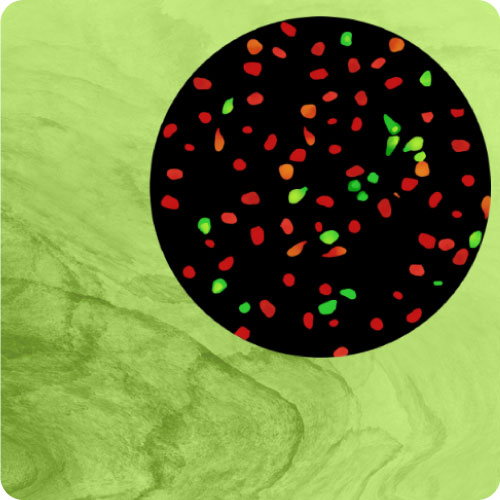Diabetes Research
Gain insight into diabetes disease mechanisms and receptor pharmacology with bright fluorescent biosensor assays. Examine Biased agonism at the GLP-1 and GCGR receptors in cell models and GPCR second messenger signaling in pancreatic islet cells.
GPCR Signaling in Diabetes
- Monitor cAMP, DAG, Calcium, and Arrestin signaling kinetics with live-cell, fluorescent GPCR signaling assays.
- Green and red fluorescent biosensor assays can be combined to detect simultaneous signaling in the same cells or wells.
- Easily co-transduce GPCRs including the GLP-1 receptor (#Z0609N), GIP receptor (#Z1609N), and Glucagon receptor (#Z2009N) in cell models of diabetes.
GLP-1R and GCGR Arrestin Recruitment
Two GPCRs relevant to diabetes signaling pathways – GLP-1R and GCGR – are now available as Borealis arrestin kits! Use cADDis cAMP and Borealis arrestin assays to examine receptor pharmacology in cell models.
Borealis Arrestin GLP-1 receptor kits include the Green fluorescent arrestin sensor, GLP-1R, and GRK 5 packaged in BacMam.
Borealis Arrestin Glucagon receptor kits include Green fluorescent arrestin sensor and GCGR packaged in BacMam.
Gain pharmacological insights from the kinetic data provided by these assays by using Pharmechanics’ Time Course Tool Pack.
Expression in Pancreatic Islet Cells
Use assay-ready BacMam vectors to express fluorescent biosensors in pancreatic islets and image signaling kinetics. Target expression to specific cell sub-populations with custom promoters. Alternate viral vectors (AV, Lentivirus, AAV) are available by special order as well.
See example research utilizing our assays in pancreatic cell types below:
Pancreatic Cell References
Primary Cultures
Pancreatic Islets (Human)
- A. Hamilton, et al. Nicotinic signaling stimulates glucagon secretion in mouse and human pancreatic α-cells. Diabetes. October 2024.
- N. Zaïmia, et al. GLP-1 and GIP receptors signal through distinct β-arrestin 2-dependent pathways to regulate pancreatic β cell function. Cell Reports. October 2023.
- J. Cho, et al. Islet primary cilia motility controls insulin secretion. Science Advances. September 2022. (bioRxiv)
- J. Almaça, et al. Human beta cells produce and release serotonin to inhibit glucagon secretion from alpha cells.Cell Reports, Volume 17, Issue 12, 2016.
Pancreatic Islets (Mouse)
- I. Davies, et al. Chronic GIPR agonism results in pancreatic islet GIPR functional desensitisation. Molecular Metabolism. January 2025.
- C. Bonner, et al. Metabolic State Determines Central and Peripheral Mechanisms of Liraglutide-Enhanced Insulin Secretion. Research Square. December 2024.
- A. Ali, et al. Comparative Effects of GLP-1 and GLP-2 on Beta-Cell Function, Glucose Homeostasis and Appetite Regulation. Biomolecules. November 2024.
- LE Eid, et al. In vivo functional profiling and structural characterisation of the human Glp1r A316T variant. bioRxiv. October 2024.
- A. Oqua, et al. Molecular mapping and functional validation of GLP-1R cholesterol binding sites in pancreatic beta cells. bioRxiv. June 2024.
- C. Hinds, et al. Abolishing β-arrestin recruitment is necessary for the full metabolic benefits of G protein-biased glucagon-like peptide-1 receptor agonists. Diabetes, Obesity and Metabolism. October 2023.
- N. Zaïmia, et al. GLP-1 and GIP receptors signal through distinct β-arrestin 2-dependent pathways to regulate pancreatic β cell function. Cell Reports. October 2023.
- S. Bitsi, et al. Divergent acute versus prolonged pharmacological GLP-1R responses in adult β cell–specific β-arrestin 2 knockout mice. Science Advances. May 2023.
- S. Bitsi, et al. Divergent acute versus prolonged in vivo GLP-1R responses in β-arrestin 2-deleted primary beta cells. bioRxiv. April 2022.
- A. Kim, et al. Arginine-vasopressin mediates counter-regulatory glucagon release and is diminished in type 1 diabetes. eLife. November 2021. (bioRxiv)
- M. Draper, et al. Imaging Meets Cytometry: Analyzing Heterogenous Functional Microscopic Data from Living Cell Populations. J. Imaging. January 2021.
- N. Daram, et al. Glucagon-like Peptide 1 Shows Glucose Dependence in Regulating Islet Hormone Secretion. Metabolism. March 2020.
- M. Marasco et al. Interleukin-6 Reduces b-Cell Oxidative Stress by Linking Autophagy With the Antioxidant Response. Diabetes. August 2018.
- A. Hamilton et al. Adrenaline Stimulates Glucagon Secretion by Tpc2-Dependent Ca2+ Mobilization From Acidic Stores in Pancreatic α-Cells. Diabetes. June 2018.
- M. Shigeto, et al. GLP-1 stimulates insulin secretion by PKC-dependent TRPM4 and TRPM5 activation. J Clinical Invest. 2015. doi:10.1172/JCI81975.
α-Cells (Mouse)
- J. Knudsen, et al. Dysregulation of Glucagon Secretion by Hyperglycemia-Induced Sodium-Dependent Reduction of ATP Production. Cell Metabolism. February 2019.
Cell Lines
EndoC-βH1
- G. Roy, et al. VDAC1 is a target for pharmacologically induced insulin hypersecretion in β cells. Cell Reports. June 2025.
- G. Roy, et al. Target deconvolution of an insulin hypersecretion-inducer acting through VDAC1 with a distinct transcriptomic signature in beta-cells. bioRxiv. December 2024.
EndoC-βH5
- C. Hinds, et al. Abolishing β-arrestin recruitment is necessary for the full metabolic benefits of G protein-biased glucagon-like peptide-1 receptor agonists. Diabetes, Obesity and Metabolism. October 2023.
INS-1 (GRINCH)
- C. Amos, et al. Membrane lipids couple synaptotagmin to SNARE-mediated granule fusion in insulin-secreting cells. Molecular Biology of the Cell. December 2023.
INS-1 832 (3 insulinoma cells25)
- G. Austin, et al. GLP-1R associates with VAPB and SPHKAP at ERMCSs to regulate β-cell mitochondrial remodelling and function. bioRxiv. February 2025.
- Y. Manchange, et al. Engineered mini-G proteins block the internalization of cognate GPCRs and disrupt downstream intracellular signaling. Science Signaling. July 2024.
- A. Oqua, et al. Molecular mapping and functional validation of GLP-1R cholesterol binding sites in pancreatic beta cells. bioRxiv. June 2024.
- G. Austin, et al. An inter-organelle contact between endosomal GLP-1R, ER VAP-B, and the mitochondrial AKAP SPHKAP triggers PKA-dependent MIC19 phosphorylation and β-cell mitochondrial remodelling. bioRxiv. April 2024.
- C. Hinds, et al. Abolishing β-arrestin recruitment is necessary for the full metabolic benefits of G protein-biased glucagon-like peptide-1 receptor agonists. Diabetes, Obesity and Metabolism. October 2023.
MIN6
- C. Wu, et al. Discovery of ciliary G protein-coupled receptors regulating pancreatic islet insulin and glucagon secretion. Genes & Development. August 2021. bioRxiv.
- Q. Wang, et al. Regulator of G protein signaling Gβ5-R7 is a crucial activator of muscarinic M3 receptor-stimulated insulin secretion. FASEB J. Jul. 7,2017.
α-TC9
- C. Wu, et al. Discovery of ciliary G protein-coupled receptors regulating pancreatic islet insulin and glucagon secretion. Genes & Development. August 2021. bioRxiv.
BacMam-mediated cADDis cAMP Sensor expression in a pancreatic islet. Shigeto, et al. 2016.
Measuring long term GPCR signaling and arrestin recruitment using fluorescent biosensors
GLP-1, glucagon and GIP receptor signaling dynamics were quantified using fluorescent cAMP and arrestin recruitment biosensors, identifying major differences of the duration of signaling between receptors, and between different agonists activating the GLP-1 receptor.

